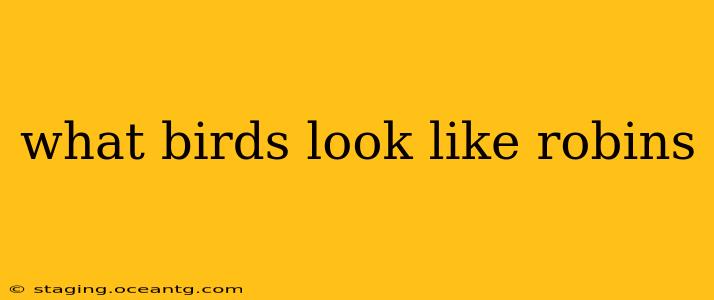The American Robin, with its iconic red-orange breast and cheerful song, is a familiar sight across North America. However, several other bird species share similar characteristics, leading to occasional confusion. This guide will delve into the world of birds that resemble robins, highlighting key features to help you distinguish them.
What are the Key Features of a Robin?
Before we explore look-alikes, let's establish the key identifying features of the American Robin:
- Red-orange breast: This is arguably the most distinctive feature, although the intensity of the color can vary.
- Brown back: A relatively uniform brown, often appearing slightly darker on the wings.
- Grayish-brown head: A muted gray-brown, often blending subtly into the back coloration.
- Yellowish beak: A slender, pointed beak, typically a yellowish-orange color.
- Size: Around 10 inches in length.
Understanding these features will make it easier to compare them to similar species.
What Birds are Often Mistaken for Robins?
Several birds share visual similarities with robins, leading to frequent misidentification. Let's explore some of the most common look-alikes:
1. Eastern Bluebird
The Eastern Bluebird is often confused with the robin due to its reddish-brown breast. However, the bluebird boasts a vibrant blue back and wings, instantly setting it apart. Its breast coloration is also less intense and more spread across the chest, lacking the defined spotting of the robin. Furthermore, the bluebird's beak is typically a darker, more bluish-gray than the robin's yellowish beak.
2. Northern Mockingbird
The Northern Mockingbird, while possessing a gray-brown back, has a whiter breast with subtle gray markings, distinctly different from the robin's uniform red-orange breast. These birds are also known for their exceptional mimicry skills, often singing a complex range of sounds. Their longer tail and slightly slimmer build can also help with identification.
3. Spotted Towhee
The Spotted Towhee's rusty-red flanks (sides) might be confused with a robin's breast at a distance. However, the Towhee lacks the robin's distinct breast color and generally has a darker, more streaked appearance. They have a bold black cap and a dark, heavily streaked back. Their behavior is also different—Towhees are more often found scratching in leaf litter.
4. European Robin
For those outside of North America, the European Robin is another species often compared to its American cousin. While possessing a similar red-orange breast, the European Robin's coloration is generally more intense, and it lacks the brown back of the American Robin. Its back is a more olive-brown, and it’s generally smaller in size.
5. Other Thrushes
Various thrush species, depending on location and plumage variation, may exhibit similar coloration. However, close examination of details—such as breast markings, back coloration, and beak shape—usually reveals distinguishing features. A good field guide, with regional bird species identified, can be beneficial for accurate identification.
How to Tell Robins Apart from Look-A-Likes
The key to accurate bird identification lies in careful observation. Pay attention to:
- Breast coloration: Is it a uniform red-orange, or is it streaked or mottled?
- Back coloration: Is it a uniform brown, or is it blue, gray, or streaked?
- Head markings: Are there distinct markings on the head, such as a cap or eye stripe?
- Beak color and shape: Is the beak yellowish-orange, or is it darker?
- Size and shape: How does the size and overall shape of the bird compare to a robin?
- Habitat: Where is the bird located? Different bird species have preferences for specific habitats.
By carefully considering these features, you can confidently distinguish robins from their look-alikes.
What are some common bird identification resources?
Several resources can assist in bird identification:
- Field guides: These books offer detailed descriptions, illustrations, and range maps of various bird species.
- Bird identification apps: Numerous apps use image recognition to help identify birds.
- Online bird databases: Websites like the Cornell Lab of Ornithology's All About Birds provide comprehensive information on bird species.
- Local bird clubs and organizations: These groups often offer bird walks and workshops to help beginners learn bird identification.
Using a combination of these resources can significantly improve your ability to identify different bird species, distinguishing robins from their many imitators. Remember, practice makes perfect! The more you observe, the easier it will become to spot the subtle differences between similar-looking birds.
